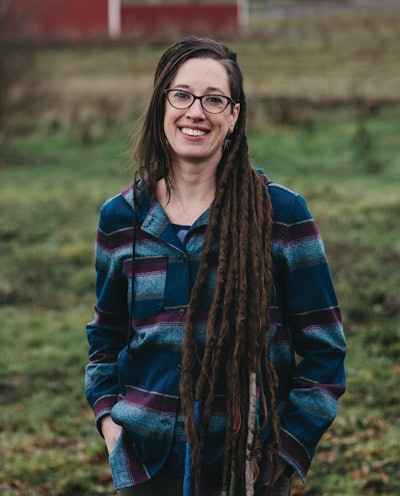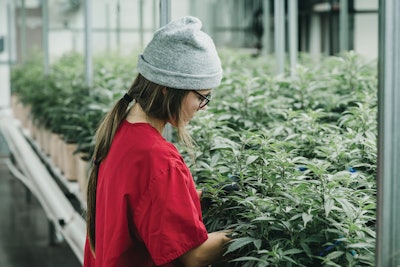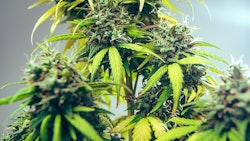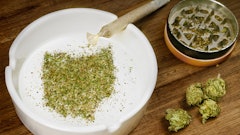

For most cultivators, surviving in the cannabis industry is no simple task. Surviving in the cannabis market while promoting sustainable and organic practices is even less so. And surviving in the Oregon market that features razor-thin and still-shrinking margins while promoting better cultivation practices? That’s a test of mettle.
But Laura Day and her Yerba Buena team have no interest doing things the easy way if they aren’t also the right way.
And the group can hustle.
In addition to being Day's pride and joy, her “baby,” Yerba Buena is one of Oregon’s premier craft cannabis businesses. Day and her team grew the 11,000-square-foot mixed-use operation (split between 7,000 square feet of indoor canopy and a 4,000-square-foot outdoor farm) from a small, local medical enterprise to an award-winning business and a target of a large acquisition deal—all in five years.

This accelerated timeline is a result of Day holding herself, the company and those around her to a higher standard. “In every industry, you're going to have a whole spectrum of practices,” Day says. “We're really interested in creating a product that is produced in a sustainable way.”
Sustainability is a big item at Yerba. For the Oregon company, sustainability means following proper organic cultivation practices and operating with better business standards.
“I mean, the name of our brand is Yerba Buena,” Day says, which she explains translates (phonetically) to “good herb” from Spanish. “Goodness is part of our name,” she adds. Good intent, good practices, good results, they all tie in together.

Once Bitten, Twice Certified
As a former dispensary manager in Arizona, Day understands the value of third-party certification in the cannabis industry. In her time making purchases for the medical dispensary in The Grand Canyon State, she would come across growers who made claims about cannabinoid content or having organic products. But when Day had the product tested, many results would show otherwise. “Without a third-party certification, you're going off of a grower's claim,” Day says.
Yerba Buena doesn’t just talk the sustainability and organic talk—the company walks the certification walk. Yerba is both Clean Green Certified and Certified Kind. While both indicate that the product was manufactured with sound environmental practices, the Clean Green certification highlights Yerba’s organic cultivation methods (federal law prohibits cannabis from being certified organic by the U.S. Department of Agriculture), while being Certified Kind indicates that Yerba Buena’s business practices are Earth-friendly as well as organically grown.
“For example, inputs such as bat guano can be sourced from very sensitive populations of bats,” Day says. “And obviously, we want all of our inputs to be sourced in a way that doesn't damage the environment or put pressures on species.”
In addition to adopting best production practices recommended by these groups, Yerba Buena is a founding member of the Resource Innovation Institute, a non-profit organization advancing resource efficiency in the cannabis industry. Day also serves as the vice president of the Cannabis Certification Council (CCC), a non-profit group “focused on education to help drive demand for transparency, clean, and sustainable production in the cannabis industry,” according to the organization’s website.

“We want to educate consumers as far as which certifications they find align with their values. There are a lot of different certifications and each have different standards,” Day says of her work with the CCC. “Just because a product is OMRI [Organic Materials Review Institute]-listed or organic doesn't necessarily mean that it's healthy for human consumption.”
Another benefit of working with third-party certification groups is that some of those groups also vet product suppliers, which Day says helps Yerba make better decisions when it comes to selecting vendors and suppliers.
“Hearing from the folks that have relationships with the manufacturers of these products … has helped us make more informed decisions as far as which [manufacturers] have good business practices and actually care about the inputs that they're using in their formulations, and those … that are just trying to skate by to get that OMRI-listing so that they can qualify as an organic input,” she says.
Sustainably Grown
A fellow Arizona cannabis market veteran, Derek Rayhorn, Yerba Buena’s lead cultivator, says adopting those organic standards and learning how to be more Earth-conscious was an interesting challenge. He describes Arizona as a market where “there [are] not as many regulations, the market doesn't care as much about organic flower, they just want something on the shelf.” Oregon’s market, however, “demands a high quality, and people are way more concerned about what they put in their body. So switching to an organic program … was definitely a learning curve.”
Instead of pesticides, Yerba Buena relies on beneficial insects, such as predatory mites and other biologicals, and on tight control over the cultivation environment to prevent pest and disease outbreaks. The company’s environmental control system (ECS) alerts staff via text message of any spikes or drops in temperature or humidity.
Other than the ECS and the irrigation system, Yerba Buena is a relatively low-tech operation when it comes to cultivation. Compost feedings are done manually by the company’s eight-member grow staff (along with a light watering because “we find that our plants here like to be hand-watered with the compost,” Rayhorn says).
Part of the reason for that low-tech approach, Rayhorn says, is because humans “have developed a very important relationship with cannabis plants in the thousands of years that we’ve been using them, so we like to have hands on the plants.”

The other reason is logistical: Rayhorn and his team can be interacting with 15 or 20 different cultivars in each room, and each plant might be going through its own growth patterns. “Pushing a button and having an [injector system] pull the nutrients out of tanks would be great,” Rayhorn admits, “but we really try to specifically target our plants’ needs, and it takes people to do it,” and with more than 100 cultivars on the roster, the cultivation team needs “people with a good eye, too.”
That personal touch goes beyond daily plant scouting. For example, Rayhorn noticed that plants would show signs of stress if they were moved from veg to flower immediately after being transplanted from 1-gallon pots to 5-gallon pots with a blooming soil containing phosphorous. Instead of having crops go through all these stressors at once, Yerba places recently re-potted plants back into the vegetation room for a short while before making their transition into flowering.
“We find that the plants are a lot happier and healthier when they can go back in their old room, hang out for a week or more, and then go into the bloom room,” Rayhorn says. Without daily inspection and care, it's easy to overlook signs of stress.
The lack of labor-savings that comes with automation and the added expenses of adhering to organic and sustainable practices certainly increase cultivation costs, but “the Oregon market demands a really high-quality product, and organic matters to people now more than ever, which is a good thing,” Rayhorn says.
A switch to LED lights in its vegetation rooms in 2017 did allow Yerba Buena to save more than $22,000 per year on its utility bill. The company was able to replace each 59-watt T5 lamp with 28-watt tubular LEDs, representing annual energy savings of more than 258,600 kilowatt hours, according to a report from the Energy Trust of Oregon.
The transition to LEDs was much smoother for Rayhorn than adapting to organic practices: Yerba found “LED bulbs that fit directly into our normal T5 fixtures, so all we had to do was take the fluorescent [bulbs] out that came with the lights,” he says. The project cost $29,900, according to the Energy Trust report, but it noted that “Yerba Buena received a $15,000 cash incentive from Energy Trust, bringing the company’s payback to approximately nine months.”
Today, Rayhorn is testing LEDs in Yerba’s flower room, one from BIOS, and the other from OSRAM, “and we're having really good luck with both of them,” he says. “So I would guess it's just a short matter of time, and capital, before we convert all of our HPS lights to LEDs.”

Data Deep-Dive
Being handcuffed by the necessary expenses of its cultivation practices forces Yerba Buena to get savvy with its cost-cutting efforts. So to find more efficiencies and ensure the company is getting everything out of its crop, the company hired a full-time data analyst.
Mary-Jane Brooks explains that her role as data analyst consists of “understanding the operations and the systems … and then translating that into collecting the information in a way that will help us learn and give us a strategic advantage in our operations and our strategy.”
Typically, Brooks works on analyzing the hundreds of data points that Yerba collects from quantitative data–such as a plant's feeding at any specific point in its life-cycle–to qualitative data, like the post-harvest team’s evaluations of a cultivar’s handling ease (i.e., its stickiness), test results and sales data. She then presents her findings and reports to management so they can make better-informed decisions.
Collecting data like humidity, temperature, lighting quality and photoperiod is easy. (Most ECSs have built-in data-tracking tools to map out environmental data.) The challenge comes when trying to track points that require manual measurements that must feed into Yerba’s proprietary data analysis system, like the plants’ height when they go into bloom and their height when they come out of bloom. So Brooks developed a desktop app that acts as a digital log for the cultivation team. Instead of writing notes and comments in a printed harvest planner, staff log into the app and note their readings on the computer. Those notes automatically get transferred into the data-analysis system, giving Brooks daily updates on any given plant, bed or room.
The cultivation room data, combined with third-party potency testing results, tells Brooks whether a particular room, bed or cultivar is under-performing according to company standards. Target yields at Yerba vary by cultivar. Generally, the company aims for a per-plant yield of 50 percent market-ready flower, 25 percent of “littles” (smaller, less aesthetically appealing buds), and 25 percent by-products (stems, leaves) for extraction.
“We don't have a processing unit. We're selling by-product to a processor, and we don't get nearly as much income for that compared to flower,” Brooks says. “So with our business setup, we want to produce more flower. For each plant, our goal is to have a greater proportion of flower versus by-product material.”
Data collection extends beyond cultivation and into the post-harvest processes. Post-harvest team members can select different tasks on a smartphone app that times how long it takes to complete. Trimmers, for example, sign into the app, select the trimming task, and a timer automatically calculates how much time is spent trimming a particular batch or cultivar. That information then is uploaded to the data-analysis tool.
This insight allows Brooks to analyze labor costs for each product, as well as monitor staff efficiencies–for example, if a “trimmer is just having a hard time and needs to get a little more training,” she says. Likewise, if the entire trimming team is getting bogged down by a particularly sticky cultivar, then Brooks can also spot that inefficiency and recommend the variety be removed from the company’s roster, as it can't be processed fast enough.
Having everything digitized instead of evaluated on paper also grants Brooks instant insight to catch mistakes before they become an issue. For example, if a trimmer has a typo in the “flower weight” column, the app will notice that the total weight is not the same as the starting weight and will flag the error for the trimmer to fix. If staff work on paper, it might take three weeks for another staff member to notice an error, at which point it’s too late to correct, Brooks says.
Right, Not Easy
One might think that working in a closely monitored environment would be off-putting, but Yerba’s staff understands the data tracking exists to help them, not to punish or micromanage them. In fact, the entire business is there to help them.
“It's one of the best jobs I've ever had,” says Amy Zents, a cultivation specialist at Yerba. “It's great to be able to come to work and know that the entire company has got your back and is going to support you in what you need … to grow the finest cannabis that you can.”
Don’t take the staff’s word for it: Oregon Business Journal listed Yerba Buena in its 2019 “100 Best Companies to Work For” rankings. (That’s across all industries, not only cannabis.) The company earned that ranking because it does things differently than most other businesses.
For starters, Yerba pays every employee a living wage—the average salary is $50,612—and covers 100 percent of its staff’s health insurance premiums, which includes coverage for chiropractic and holistic services. “We do a lot to support our employees and create an excellent workplace,” Day says.
The premium on personnel has been with Yerba since its founding. “We knew that we needed the best and the brightest within the industry and those from other industries that could adapt and innovate in the cannabis industry,” says Yerba Buena’s co-founder and general manager Preston Greene. “We knew we wouldn’t be able to make it without people. You can have a great facility, great cultivars, but without people to get you through, you’re never going to make it.”
And the people Yerba hires represent the population it serves: half of Yerba’s staff is female, and nearly every minority group (LGBTQ+, racial, religious, etc.) is represented in the company. To help ensure diversity and that employee issues are appropriately handled, the staff created a Diversity Committee. “We wanted to have a smaller team within our larger team that was representing the interest of employees and the tenets to live by, whether that’s treating people kindly, being direct with people, not talking about people behind their backs,” Greene says. Those staff-developed tenets now are part of Yerba Buena’s employee handbook and employment agreements. “These are things that people are evaluated on in their performance reviews,” notes Yerba’s GM.
Yerba Buena also offers employees the opportunity to take paid days to volunteer at a charitable or community organization, and most employees participate. For example, Zents and the Yerba team helped clean public parks, picked up “a ridiculous amount” of cigarette butts off the side of a state highway and ripped invasive vines from a hillside at Jenkins Estate. The company’s drive to use best practices in cultivation and business “makes you want to share those values with the larger community,” Zents says.
Additional evidence of Yerba Buena's dedication to sustainability and best practices are the company’s back-to-back top-10 rankings in the “100 Best Green Workplaces in Oregon” list by Oregon Business Weekly (9th in 2017, 6th in 2018), which ranks employer dedication to sustainable practices.
That said, those better business practices do “come at a price, and it does increase our overhead,” Day says. “But the last thing we would cut are those special practices that make us who we are.”
Paying a living wage has drawbacks besides cutting into margins: It also means that Yerba Buena cannot hire as many staffers as companies that pay close to minimum wage. That said, “We prefer to have fewer employees that are paid more, that have greater professional development support from our company so that we end up with some of the greatest talent in the industry,” Day says. “And I think we’ve been successful in that goal.”

A Good Stem
Many, if not most, investors looking for deals in a saturated market would see thinning margins and more substantial overhead as a sign that a business is doomed. But Yerba Buena was able to show investors that its business model is viable. Its detailed data-collection and business-intelligence practices, efforts to become more efficient, its ability to sell a premium product in a saturated market while staying sustainable, and the multiple awards the company won for its workplace granted the company its pick of investment offers.
“We were seeking a group that shared and supported our values of sustainability, organic cultivation practices and creating exemplary workplaces,” Day says of Yerba Buena’s evaluation criteria. After lengthy deliberations, Stem Holdings—a cannabis acquisition and property leasing company whose portfolio includes TJ’s Gardens, Cannavore, and incredibles, among other cannabis brands—was the right fit to acquire Yerba Buena.
“Stem immediately recognized the unique value of Yerba Buena’s outstanding human talent, a bottleneck in our industry. Our team instantly clicked with Stem’s leadership, and their entrepreneurial mindset and experience with scaling businesses made this a perfect match,” Day says. “We got very lucky with this partnership.”
For Greene, the selling factor was Stem’s ability to listen. “When we sat down with Stem, they listened, asked intelligent questions and had the most exhaustive due diligence process of any of our suitors. They were the kind of people we wanted to work with because they were looking underneath the hood.”
The Oregon company underwent a three-month audit during which accountants pored through its financial records and SOPs. Stem Holdings and Yerba Buena finally agreed to terms on an acquisition deal on Oct. 9, 2018, through which Yerba Buena joins Stem Holdings’ roster of cannabis businesses. Under the agreement terms, Stem will acquire from Yerba Buena all the assets comprising Yerba Buena's business and assume the related liabilities. The consideration to be paid by Stem includes: (i) US$350,000 in cash payable on closing; (ii) a US$400,000 non-negotiable promissory note (iii) US$3.86 million in common share of Stem, according to a press release on the deal. (The acquisition will be final on Feb. 1, pending OLCC approval, Greene says. For more details on this transaction, visit: bit.ly/stem-yerba-buena.)
The new company structure is still fresh and changes are still underway—not the least of which is team members taking on new roles within Stem Holdings. Among other changes, the agreement calls for Greene to take on executive vice president responsibilities for all of Stem’s brands, while Day is moving away from her position as director of operations at Yerba Buena to assuming the “responsibilities of evaluating and informing operational efficiencies across Stem’s strong portfolio of brands as we scale into new markets,” she says. In other words, she gets to bring her brand of business to a broader audience.
Day doesn’t see her transition away from the day-to-day at Yerba Buena as something to lament. Instead, she sees the good that she gets to bring to the world in her new position. “I see this merger as an opportunity to continue setting standards of exemplary business practices and progressive values in the cannabis space,” she says.
And if Day has her way, consumers will be saying: Bring on the Good Herb.

























